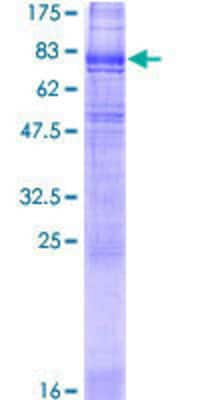SLC6A3/DAT1: Proteins and Enzymes
The dopamine transporter (DAT) is a 70 - 80 kDa member of the Na+-neurotransmitter symporter family of transmembrane (TM) proteins. DAT plays a crucial role in the synaptic clearance of dopamine (DA). It mediates the uptake of dopamine by the presynaptic terminal, thus limiting the strength of the dopamingeric response. One molecule of DA is accompanied by two Na+ and one Cl- ion. Molecules such as amphetamine both competitively inhibit DA uptake, and induce DA release through the DAT, increasing the rewarding property of DA.
The human dopamine transporter is a 620 amino acid (aa), 12 TM phosphoglycoprotein with an N- and C-terminal cytoplasmic domain. Human DAT exists as a disulfide-linked oligomer on the cell surface. Phosphorylation of the N-terminus (S7/12) promotes DA release. The C-terminus binds CaMKII, as well as Hic5, Pick1, and synuclein which regulate receptor trafficking and expression. There is an extended 71 aa extracellular (EC) loop between TM segments 3 and 4. Glycosylation at this site is necessary for oligomer expression on the cell membrane. The human 42 aa DAT C-terminus is 93% aa identical to the mouse DAT C-terminus. The human EC loop is also 93% aa identical to the rhesus monkey EC loop.
3 results for "SLC6A3/DAT1 Proteins and Enzymes" in Products
3 results for "SLC6A3/DAT1 Proteins and Enzymes" in Products
SLC6A3/DAT1: Proteins and Enzymes
The dopamine transporter (DAT) is a 70 - 80 kDa member of the Na+-neurotransmitter symporter family of transmembrane (TM) proteins. DAT plays a crucial role in the synaptic clearance of dopamine (DA). It mediates the uptake of dopamine by the presynaptic terminal, thus limiting the strength of the dopamingeric response. One molecule of DA is accompanied by two Na+ and one Cl- ion. Molecules such as amphetamine both competitively inhibit DA uptake, and induce DA release through the DAT, increasing the rewarding property of DA.
The human dopamine transporter is a 620 amino acid (aa), 12 TM phosphoglycoprotein with an N- and C-terminal cytoplasmic domain. Human DAT exists as a disulfide-linked oligomer on the cell surface. Phosphorylation of the N-terminus (S7/12) promotes DA release. The C-terminus binds CaMKII, as well as Hic5, Pick1, and synuclein which regulate receptor trafficking and expression. There is an extended 71 aa extracellular (EC) loop between TM segments 3 and 4. Glycosylation at this site is necessary for oligomer expression on the cell membrane. The human 42 aa DAT C-terminus is 93% aa identical to the mouse DAT C-terminus. The human EC loop is also 93% aa identical to the rhesus monkey EC loop.
| Applications: | WB, ELISA, MA, AP |
| Applications: | WB, ELISA, MA, AP, PAGE |
| Applications: | AC |


![SDS-PAGE: Recombinant Human SLC6A3/DAT1 GST (N-Term) Protein [H00006531-Q01] SDS-PAGE: Recombinant Human SLC6A3/DAT1 GST (N-Term) Protein [H00006531-Q01]](https://resources.bio-techne.com/images/products/qc_test-H00006531-Q01-1.jpg)